23.10.2017
F-22 Raptors deploy to Europe
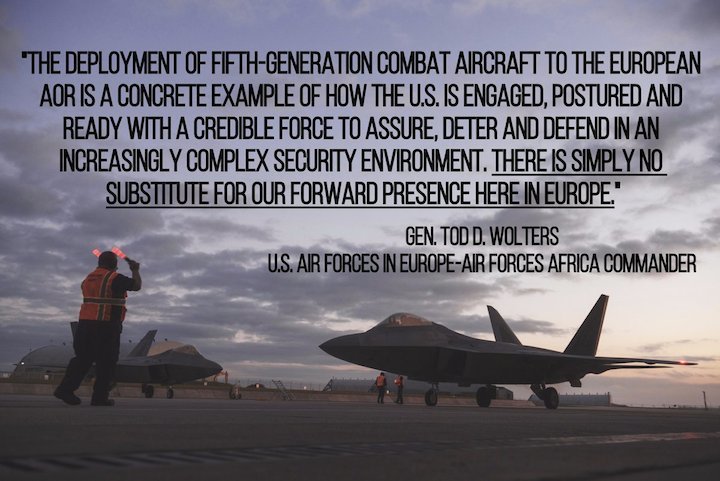
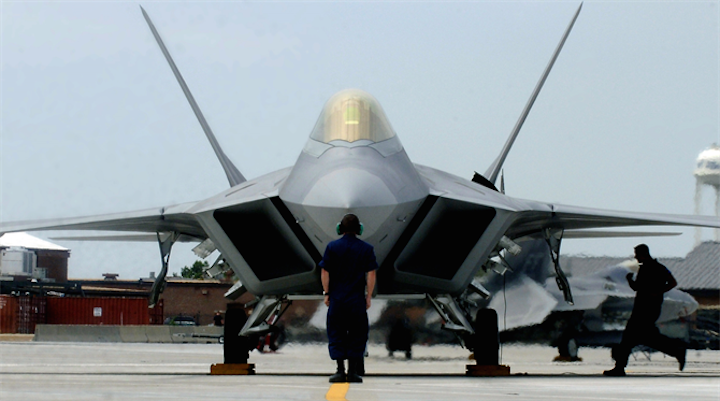
RAMSTEIN AIR BASE, Germany -- F-22 Raptor aircraft from the 1st Fighter Wing at Joint Base Langley-Eustis, Virginia have deployed to Europe for a Flight Training Deployment (FTD) to conduct air training with other U.S. Europe-based aircraft and NATO Allies.
Six aircraft and approximately 150 Airmen, who are returning to the United States from the U.S. Central Command Area of Responsibility, arrived to RAF Lakenheath, U.K. on Oct. 8. While in the European theater, the Airmen and aircraft will participate in the Royal Air Force (RAF) exercise Eastern Zephyr to conduct realistic training in a joint environment and bolster capabilities with NATO allies. In addition to participation in the RAF exercise, Airmen and F-22 aircraft have forward deployed from the U.K. to Germany and Poland to demonstrate their ability to quickly respond and reassure allies and partners that the United States Air Force is here, in Europe, forward and ready.
"The deployment of fifth-generation combat aircraft to the European AOR is a concrete example of how the U.S. is engaged, postured and ready with a credible force to assure, deter and defend in an increasingly complex security environment," said Gen. Tod D. Wolters, U.S. Air Forces in Europe-Air Forces Africa commander. "There is simply no substitute for our forward presence here in Europe."
The F-22 FTD is funded by the European Deterrence Initiative (EDI), which enhances the U.S. deterrence posture in Europe by improving the readiness and responsiveness of U.S. forces. EDI will provide approximately $1 billion in funding to the U.S. Air Force for Increased Intelligence, Surveillance and Reconnaissance processing; continued support of missions such as NATO Air Policing and Theater Security Packages; enhanced prepositioning of contingency air operations equipment; improvements to airfield infrastructure and prepositioning of air operations equipment and enablers in NATO ally countries.
The deployment of the fifth generation F-22 fighter marks the third time Raptors have deployed to Europe. The first deployment was to Spangdahlem Air Base, Germany, together with visits to Estonia and Poland in August 2015. The second was to RAF Lakenheath, U.K., along with forward locations in Lithuania and Romania in April 2016.
The F-22 Raptor is the world's premiere operational fifth-generation fighter. Fifth-generation capability combines the attributes of maneuverability, advanced and fused avionics, multi-role capability and stealth technology. Last month, when Air Force Chief of Staff Gen. David L. Goldfein hosted President Donald Trump at the Joint Base Andrews Air and Space Expo, Goldfein said air superiority is and will continue to be paramount to the success of the U.S. military and that when it comes to air superiority, the fifth generation raises the game of the fourth generation.
"The most important thing the Air Force provides the joint force is air superiority," said Goldfein. "These developments allow the Air Force to overcome advanced enemy defenses that inhibit fourth generation aircraft."
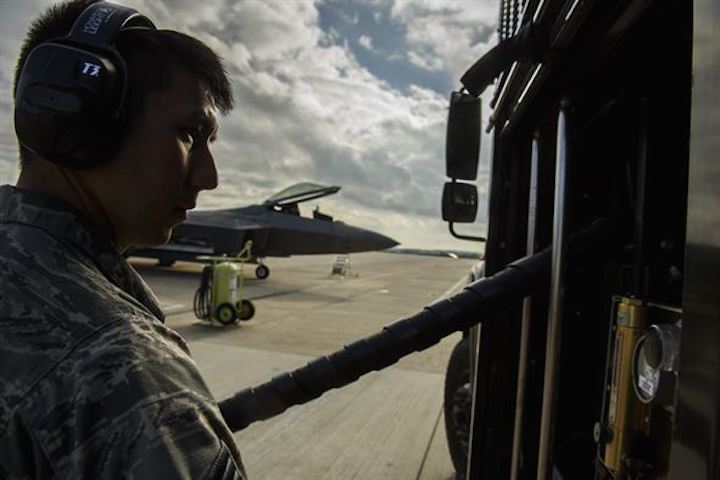
Senior Airman Josh Kampa, 52nd Logistic Readiness Squadron fuels distribution operator, refuels an F-22 Raptor assigned to the 1st Fighter Wing, Joint Base Langley-Eustis, Va., at Spangdahlem Air Base, Germany, Oct. 13, 2017. This F-22 flying training deployment is an example of how the U.S. is engaged, postured, and ready with credible force to assure, deter, and defend in an increasingly complex security environment. (U.S. Air Force photo by Staff Sgt. Jonathan Snyder)
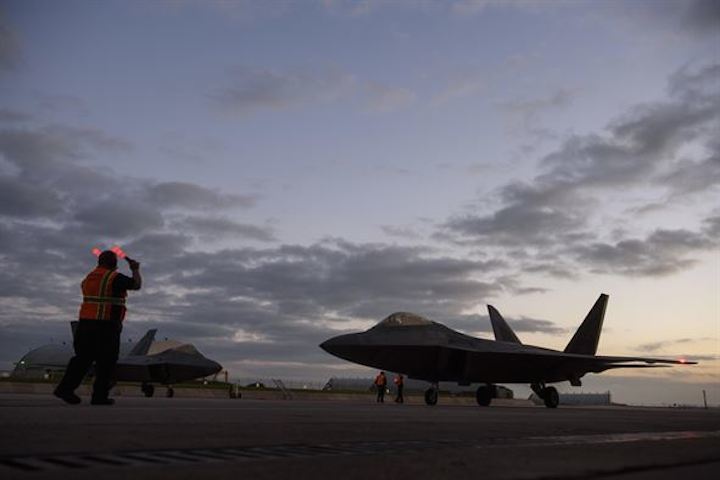
An F-22 Raptor assigned to the 1st Fighter Wing, Joint Base Langley-Eustis, Va., taxis at Spangdahlem Air Base, Germany, Oct. 13, 2017. This F-22 flying training deployment is an example of how the U.S. is engaged, postured, and ready with credible force to assure, deter, and defend in an increasingly complex security environment. (U.S. Air Force photo by Staff Sgt. Jonathan Snyder)
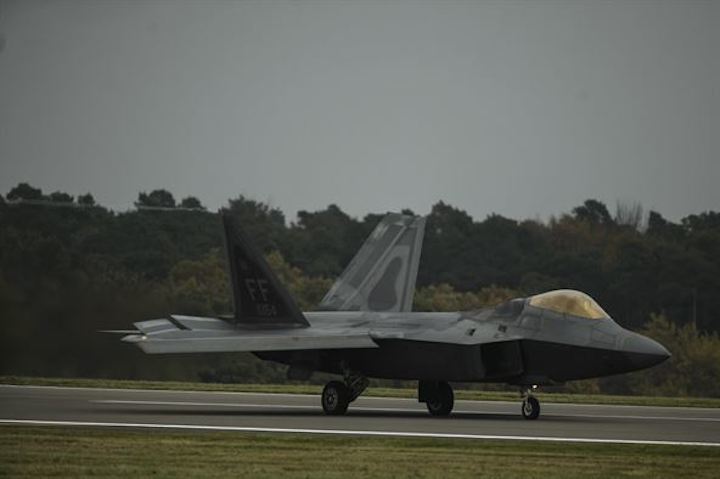
An F-22 Raptor assigned to the 1st Fighter Wing, Joint Base Langley-Eustis, Va., lands at Spangdahlem Air Base, Germany, Oct. 13, 2017. This F-22 flying training deployment is an example of how the U.S. is engaged, postured, and ready with credible force to assure, deter, and defend in an increasingly complex security environment. (U.S. Air Force photo by Staff Sgt. Jonathan Snyder)
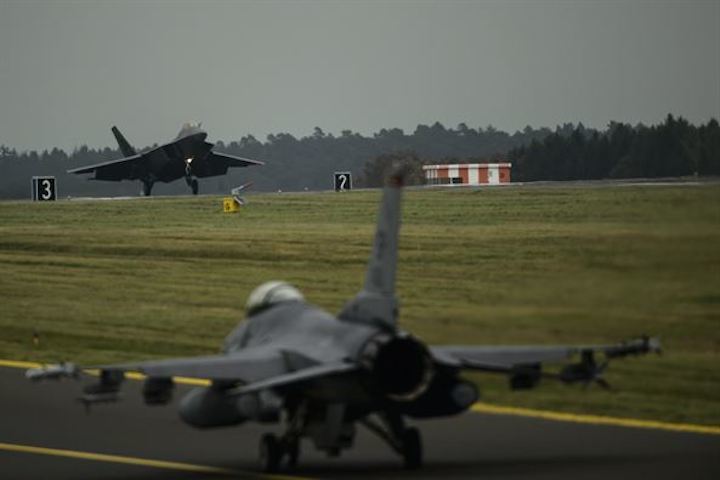
An F-22 Raptor assigned to the 1st Fighter Wing, Joint Base Langley-Eustis, Va., lands while an F-16 Fighting Falcon assigned to the 480th Fighter Squadron taxis at Spangdahlem Air Base, Germany, Oct. 13, 2017. This F-22 flying training deployment is an example of how the U.S. is engaged, postured, and ready with credible force to assure, deter, and defend in an increasingly complex security environment. (U.S. Air Force photo by Staff Sgt. Jonathan Snyder)

An F-22 Raptor pilot assigned to the 1st Fighter Wing, Joint Base Langley-Eustis, Va., conducts a preflight check at Spangdahlem Air Base, Germany, Oct. 13, 2017. This F-22 flying training deployment is an example of how the U.S. is engaged, postured, and ready with credible force to assure, deter, and defend in an increasingly complex security environment. (U.S. Air Force photo by Staff Sgt. Jonathan Snyder)
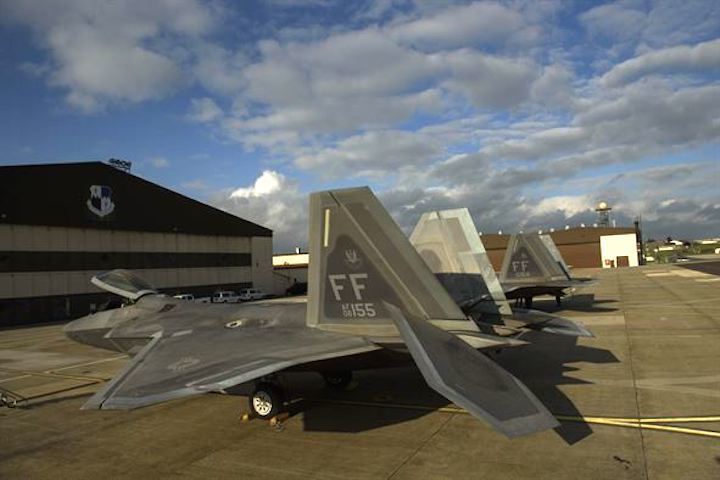
Two F-22 Raptors assigned to the 1st Fighter Wing, Joint Base Langley-Eustis, Va., sit on the flightline at Spangdahlem Air Base, Germany, Oct. 13, 2017. This F-22 flying training deployment is an example of how the U.S. is engaged, postured, and ready with credible force to assure, deter, and defend in an increasingly complex security environment. (U.S. Air Force photo by Staff Sgt. Jonathan Snyder)
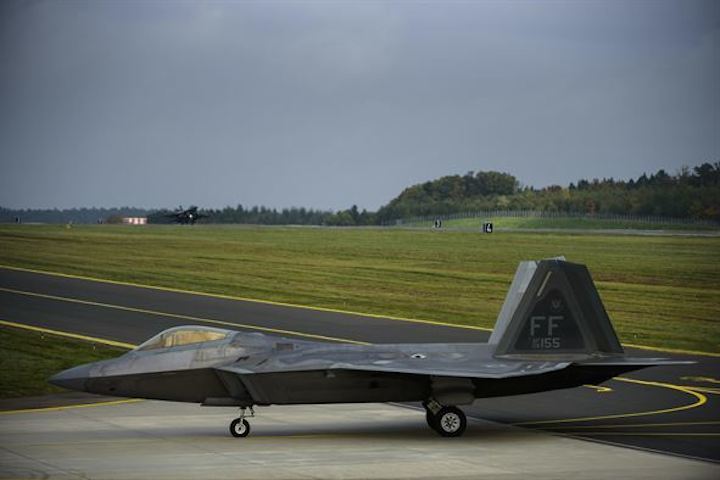
An F-22 Raptor assigned to the 1st Fighter Wing, Joint Base Langley-Eustis, Va., taxis while an F-16 Fighting Falcon assigned to the 480th Fighter Squadron lands at Spangdahlem Air Base, Germany, Oct. 13, 2017. This F-22 flying training deployment is an example of how the U.S. is engaged, postured, and ready with credible force to assure, deter, and defend in an increasingly complex security environment. (U.S. Air Force photo by Staff Sgt. Jonathan Snyder)
F-22 Raptor
Mission
The F-22 Raptor is the Air Force's newest fighter aircraft. Its combination of stealth, supercruise, maneuverability, and integrated avionics, coupled with improved supportability, represents an exponential leap in warfighting capabilities. The Raptor performs both air-to-air and air-to-ground missions allowing full realization of operational concepts vital to the 21st century Air Force.
The F-22, a critical component of the Global Strike Task Force, is designed to project air dominance, rapidly and at great distances and defeat threats attempting to deny access to our nation's Air Force, Army, Navy and Marine Corps. The F-22 cannot be matched by any known or projected fighter aircraft.
Features
A combination of sensor capability, integrated avionics, situational awareness, and weapons provides first-kill opportunity against threats. The F-22 possesses a sophisticated sensor suite allowing the pilot to track, identify, shoot and kill air-to-air threats before being detected. Significant advances in cockpit design and sensor fusion improve the pilot's situational awareness. In the air-to-air configuration the Raptor carries six AIM-120 AMRAAMs and two AIM-9 Sidewinders.
The F-22 has a significant capability to attack surface targets. In the air-to-ground configuration the aircraft can carry two 1,000-pound GBU-32 Joint Direct Attack Munitions internally and will use on-board avionics for navigation and weapons delivery support. In the future air-to-ground capability will be enhanced with the addition of an upgraded radar and up to eight small diameter bombs. The Raptor will also carry two AIM-120s and two AIM-9s in the air-to-ground configuration.
Advances in low-observable technologies provide significantly improved survivability and lethality against air-to-air and surface-to-air threats. The F-22 brings stealth into the day, enabling it not only to protect itself but other assets.
The F-22 engines produce more thrust than any current fighter engine. The combination of sleek aerodynamic design and increased thrust allows the F-22 to cruise at supersonic airspeeds (greater than 1.5 Mach) without using afterburner -- a characteristic known as supercruise. Supercruise greatly expands the F-22 's operating envelope in both speed and range over current fighters, which must use fuel-consuming afterburner to operate at supersonic speeds.
The sophisticated F-22 aerodesign, advanced flight controls, thrust vectoring, and high thrust-to-weight ratio provide the capability to outmaneuver all current and projected aircraft. The F-22 design has been extensively tested and refined aerodynamically during the development process.
The F-22's characteristics provide a synergistic effect ensuring F-22A lethality against all advanced air threats. The combination of stealth, integrated avionics and supercruise drastically shrinks surface-to-air missile engagement envelopes and minimizes enemy capabilities to track and engage the F-22. The combination of reduced observability and supercruise accentuates the advantage of surprise in a tactical environment.
The F-22 will have better reliability and maintainability than any fighter aircraft in history. Increased F-22 reliability and maintainability pays off in less manpower required to fix the aircraft and the ability to operate more efficiently.
Background
The Advanced Tactical Fighter entered the Demonstration and Validation phase in 1986. The prototype aircraft (YF-22 and YF-23) both completed their first flights in late 1990. Ultimately the YF-22 was selected as best of the two and the engineering and manufacturing development effort began in 1991 with development contracts to Lockheed/Boeing (airframe) and Pratt & Whitney (engines). EMD included extensive subsystem and system testing as well as flight testing with nine aircraft at Edwards Air Force Base, Calif. The first EMD flight was in 1997 and at the completion of its flight test life this aircraft was used for live-fire testing.
The program received approval to enter low rate initial production in 2001. Initial operational and test evaluation by the Air Force Operational Test and Evaluation Center was successfully completed in 2004. Based on maturity of design and other factors the program received approval for full rate production in 2005. Air Education and Training Command, Air Combat Command and Pacific Air Forces are the primary Air Force organizations flying the F-22. The aircraft designation was the F/A-22 for a short time before being renamed F-22A in December 2005.
General characteristics
Primary function: air dominance, multi-role fighter
Contractor: Lockheed-Martin, Boeing
Power plant: two Pratt & Whitney F119-PW-100 turbofan engines with afterburners and two-dimensional thrust vectoring nozzles.
Thrust: 35,000-pound class (each engine)
Wingspan: 44 feet, 6 inches (13.6 meters)
Length: 62 feet, 1 inch (18.9 meters)
Height: 16 feet, 8 inches (5.1 meters)
Weight: 43,340 pounds (19,700 kilograms)
Maximum takeoff weight: 83,500 pounds (38,000 kilograms)
Fuel capacity: internal: 18,000 pounds (8,200 kilograms); with 2 external wing fuel tanks: 26,000 pounds (11,900 kilograms)
Payload: same as armament air-to-air or air-to-ground loadouts; with or without two external wing fuel tanks.
Speed: mach two class with supercruise capability
Range: more than 1,850 miles ferry range with two external wing fuel tanks (1,600 nautical miles)
Ceiling: above 50,000 feet (15 kilometers)
Armament: one M61A2 20-millimeter cannon with 480 rounds, internal side weapon bays carriage of two AIM-9 infrared (heat seeking) air-to-air missiles and internal main weapon bays carriage of six AIM-120 radar-guided air-to-air missiles (air-to-air loadout) or two 1,000-pound GBU-32 JDAMs and two AIM-120 radar-guided air-to-air missiles (air-to-ground loadout)
Crew: one
Unit cost: $143 million
Initial operating capability: December 2005
Inventory: total force, 183
Quelle: USAF
